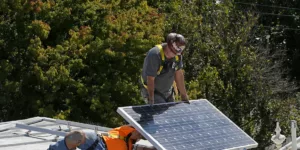Homebuilding technology may not seem like it’s changed much in the past 20 years, especially when compared to tech advances like smartphones and the apps we use on them. After all, homes are still built with the same foundations, a similar assortment of building materials, and with the same purposes in mind.
But gradually, we’ve come to enter a new era of homebuilding—and there are a handful of new technologies driving those important changes.
The Technologies to Watch
If you haven’t been watching these three important technologies develop, now’s the time to start watching them:
- Architectural rendering tech. First, we’re seeing the emergence of much more sophisticated architectural rendering tech. Lumion software, for example, empowers architects to visualize their designs in incredibly lifelike simulations; they get to see the texture of the building they’re planning, and evaluate how it looks in its natural environment. This allows architects to play with more options, and get a much more nuanced feel of how their designs will work, long before they’re solidified. Drone technology is also assisting with the design project, making it easier for architects and building planners to scout the land and take detailed photographs, which can then be used to produce even more accurate renderings.
- 3D printing. Though not yet mainstream, 3D printing technology may allow homes to be constructed faster than ever—all while saving costs. Construction startup ICON and housing nonprofit New Story recently announced their ability to 3D print an entire 650-square-foot house within 24 hours, and with costs around $10,000. Similar 3D printing projects with fewer features, with developing countries in mind, could cost as low as $4,000 each. If this technology gets more efficient, the costs and speeds could improve even further. Right now, the biggest obstacle is scaling to a point where these homes are available for everyone—and aren’t just sophisticated test runs.
- Autonomous building equipment. We’re also seeing the rise of autonomous robots designed explicitly for building houses, assembly-line style. In Central Thailand, the SCG Heim factory (a joint venture between the Siam Cement Public Company and Sekisui Chemical Group) is making this futuristic vision a reality. Giant machines with robotic arms can run independently to weld pieces of steel or aluminum, providing steel structures for houses that are finished using other materials. The factory is capable of churning out more than 1,000 houses per year.
The Impacts :
So what does this mean for you? If you’re in the homebuilding industry (as an architect or a contractor, for example), these new technologies have the power to transform your role—or even your entire organization. But as an everyday consumer, it’s more likely you’ll see the following results:
- Creativity and flexibility. Thanks to new rendering software, and tools that provide more power and freedom to designers, architects are capable of creating much more unique, flexible home designs. They can push the limits of their creativity, and produce plans that can be constructed faster and more accurately than ever before.
- Cost efficiency. A combination of cheaper materials, 3D printing, and automation is also making the home construction process more cost-effective. People at every phase of development are working faster and more efficiently, producing more homes in less time. Already, we’re seeing livable homes that are being produced for $10,000 or less; advancing technology may be able to drive those prices down even further.
- Accessibility. Tech is also making homes more accessible. With automation on our side, we can produce a full home in 24 hours, or more than 1,000 houses a year (from a single company). Because 3D printers can be mobilized, we can also construct homes on the fly almost anywhere. This makes homes more affordable and more accessible to practically everyone, regardless of income or location, and could make new home construction a more powerful industry.
As homebuilding technology becomes even more sophisticated, and breaks ground in areas we haven’t yet considered, expect to see further changes along these broad lines. Homes may never be at once cheap, reliable, and beautiful, but we’ll have the tools we need to get closer to perfection in all three directions.








